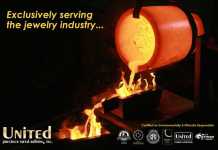
MULTIPLYING POTENTIAL
How Goldstar Independent is opening doors – for its own business as well as that of its customers
by Wayne Karl
Imagine operating a business in which a simple, yet effective, innovation opens doors and extends your reach – not only to new customers, but to your customers’ customers. This is the position Goldstar Independent LLC finds itself in these days, thanks to a key product line.
Goldstar Independent, a unit of parent Goldstar in India, has operated out of New York City for the last 12 years, with a small Canadian sales presence beginning in June 2012.
A common structure, perhaps, for a manufacturer and wholesaler which supplies major retailers such as Peoples Jewellers, Michael Hill, JC Penney and Walmart, as well as other wholesalers. Even the company’s product line (ranging from sterling silver and 10-, 14- and 18-karat gold jewellery and a wide variety of diamond qualities) might not seem overly noteworthy.
But it’s the market reception and potential of one of its newer areas of business that have NY-based president and CEO Amit Patel and his Toronto-based Canadian sales director, Jesin Ghatalia, especially excited.
The product line in question? The company’s Ttva “innovative solitaire” diamonds, a patented process that involves combining smaller diamond pieces together to make them look like larger singular stones. The benefits? A one-carat centre stone, for example, can look 50 per cent larger than a traditional one-carat solitaire – but cost one-fifth the price.
Available in a variety of shapes – from oval to emerald to round and even heart-shaped – composite stones are a key target for growth in the U.S. and Canada, Patel says. Goldstar plans to open an office in Toronto around this time next year to take advantage of the potential of Ttva and other product areas.
“(Ttva) is a business in which we currently have no competitors, because it’s a patented product,” says Patel.
RETAILERS TO PROFIT
The product of years of research and development at Goldstar in India, where the factory operates at full capacity cutting stones, the technology allows the company to utilize diamond pieces. Patel says it has really taken off in the last few years, first in the U.S., and now in Canada.
As a cost comparison, a three carat round or cushion stone, at SI1 clarity and G colour, would cost approximately $20,000 to $25,000.
“My three-carat look, which is equal to a .70 or .80 point stone, would cost only $2,000,” says Patel. “Not everyone can afford, $20,000, $30,000 or $50,000 on a stone. So this is for that market, which in today’s world, with the economy the way it is…”
He continues with the example of a middle-class American making $100,000 a year. That consumer is not going to be able to walk into a jewellery store and pay $50,000 cash for a wedding set. “We’re giving him a $50,000 look for a fraction of the price,” says Patel. “We sell it for $3,000 or $4,000 to our retailers, who are able to sell it for $10,000 to $12,000 to their customers.”
The strategy pays two dividends: increasing Goldstar’s reach to retail clients, who in turn are able to offer something new to their customers; and it affords retailers a product line that yields a higher profit margin.
“When a customer (retailer) sells a diamond that’s worth $25,000, he’s lucky to make 10 to 20 per cent,” says Patel. “The margins on loose diamonds are very thin – they make all the money in the mounting.
“Our product allows for the retailer to make more money, with faster turn. A retailer might sell only one regular stone a month, but with our bridal sets, for example, he can sell at least three or four.”
Ghatalia recently called on a high-end jewellery store in Edmonton, leaving behind three Ttva pieces for the retailer to test consumer interest. By the time Ghatalia returned to Toronto a few days later, the customer called saying he had sold two pieces in three days. He doubled the re-order for the same two pieces to stock a second outlet as well, and ordered three new pieces.
“The market in Canada has responded very well and positively regarding Ttva,” says Ghatalia. “It’s aimed at the multi-faceted woman of today.” Ghatalia says that it’s “this woman of substance and style that Ttva truly represents. It also goes to show that you don’t have to spend millions to flaunt a great style.”
In Canada, Michael Hill carries a few Ttva designs, and every month re-orders 100 to 200 pieces, according to Patel. “And these are not small pieces, they’re $2,000 to $3,000 pieces. We’re confident in this product. Based on retailer response, there’s a lot of potential to do business.”
Goldstar plans to make Ttva a central part of its presence at trade shows in Canada. “We have already started focusing on making special designs for the Canadian market,” adds Ghatalia.
OPENING SHOP IN TORONTO
Opening an office in Toronto next year will allow Goldstar to continue its Canadian push and capture what it sees as potential growth with Ttva and other product lines. And it will mean the company can better serve retail customers. Currently, Canadian retailers are being serviced by the U.S. office, which means Ghatalia has access to a limited product line. With a full operation and expanded inventory in Canada, retail customers can visit the office and see the full product line.
“It will be much easier for us to grow the business to the level we want to take it,” says Patel.
The move could also help the bottom line in more practical ways – Canadian customers currently pay Goldstar in New York in Canadian dollars. “So, we’re taking a hit every month on the currency exchange rate,” says Patel.
As for Goldstar’s other areas of focus, machine setting and price point diamonds will also anchor its Canadian expansion.
The company’s Mystic Diamonds Collection, for example, is doing well in Canada, according to Ghatalia. This line, which comprises rings, pendants, earrings and sets, involves hidden diamonds pressure-set below a channel of round diamonds to create a complete diamond look, with no metal visible between the diamonds.
Like other manufacturers and wholesalers in the jewellery business today, Goldstar faces some challenges to its growth plans – chief among them the economy. Rising gold and diamond prices, something of a tester a few years ago, have since stabilized and allowed the company to better manage raw materials costs.
The issue now is a tepid economic climate, evidenced at times by a challenging retail environment. Traditional busy seasons such as Christmas and Valentine’s Day have simmered some, on both sides of the border.
For a manufacturer and wholesaler such as Goldstar, this means the finance cycle with retail customers has slowed. “We used to be able to turn our money maybe three times a year,” says Patel. “Now we’re doing it a time and a half or maybe two – if we’re lucky.” These challenges aside, Goldstar is confident the promise of Ttva will help the company overcome such obstacles and achieve its growth potential. CJ

















